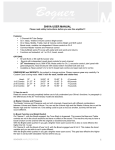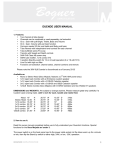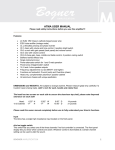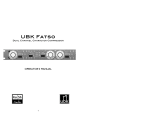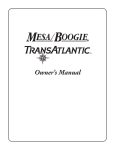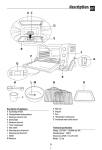Download ECSTASY MANUAL 2012 - Bogner Amplification
Transcript
Ecstasy User Manual Please read safety instructions before operating this amplifier! Thank you for purchasing the Ecstasy 101B. As modern guitar amplifiers go, the Ecstasy is not the least expensive, so we assume that you've listened very carefully to other amplifiers available on the market and we agree with you! The Ecstasy combines the sonic characteristics of the best modern and vintage amps, while offering you the technological advances you've come to expect from Bogner. This manual was designed to help you get the most from your new Bogner. We have included some tips & uses you might not have thought of, so please take a few minutes to read it. Of course, please feel free to call your Bogner dealer anytime you have questions. The Ecstasy was designed with simplicity & usability in mind. It was built with the finest materials the world has to offer so with just a tube change and a biasing every once in a while, the Bogner Ecstasy should provide you with the most wonderful sound for many, many years to come. Features: • 3 channel all tube design • Ch1: gain, bass, middle, treble and volume control • Ch1: 3 position pre eq and gain boost • Ch2: gain, volume and 3 position pre eq • Ch3: gain, volume and 3 position pre eq • Ch2 & 3: common bass, middle and treble controls • Ch2 & 3: common gain-structure, gain boost and plexi mode switch • Tube buffered effects loop, series or parallel (mix control) mode, master volume • Dual assignable presence controls with excursion switches for loose and tight feel • Half power & old/new style switch (cuts power from full to about 25 watts) • Functions on foot controller: ch1, ch2, ch3, boost 1, boost 2, fx loop, stand-by mute Options: • 120W EL34, 100W 6L6 or 45W 6V6 power amp • Class A/AB mode switch, cuts power further • Individual line-out controls for each channel (standard one common control) • Metal Grill (not available on 20thA) • Classic Circuit (discontinued) • 20thA Circuit (6L6 standard), gold plexi front panel and larger head shell DIMENSIONS and WEIGHTS: Are subject to change anytime, Please measure your amp carefully if a Custom Case is being made. Add ¾ inch for each, handle and rubber feet. Head: 20thA Head: 9.50” H 10.25” H BOGNER AMPLIFICATION 27.25” W 29.75” W 10.25” D 10.50” D 46 pounds 51 pounds 1 The Manual: Let's begin by hooking up a speaker to the Speaker 1 jack on the back panel of the Ecstasy. Be sure to set the impedance switch correctly to match your cabinet. If you're not sure what impedance your cab is, open the back of the cabinet and call your dealer. There are many ways to wire a speaker cabinet and you need to know what yours is rated at. Now plug the footswitch connector into the "Remote Control" jack on the back panel. Next, with the standby switch (front left panel) in the "standby" (down) position, flick the Power switch to the "Power" (up) position. Let the amp warm up for at least a minute or two! This will stabilize the circuits and prevent a painful surge from flashing through your tubes. If you're kind to your amp, it will reward you with grateful reliability. At this point, it might be helpful to understand the difference between Preamp and Poweramp functions. For instance, you are probably aware that the "presence" knob on most amps is a poweramp brightness control, while the "treble" knob is the preamp brightness control. Your new Bogner has been carefully laid out so that you have options regarding how the preamp and poweramp respond, both together and separately. On the front panel, turn down Vol.1, Vol.2 & Vol.3 (these are your channel masters). Make sure the loop on/off button on the rear panel is "off" and the loop light on the foot controller is off (more about this later). Plug your guitar into the "H" (HI) Input jack on the front panel (Classic and 20thA model have only the HI input) and flick the "standby" switch to "ON". Please note the “standby” switch on the foot controller is not associated with the “standby” switch on the amp, this switch is an audio signal mute so you can switch guitars silently. Tap the Green channel on the foot controller. You are now in channel 1 - the Clean Channel. Channel 1 has Gain, Bass, Middle, Treble & Vol. controls. There is a 3 position Pre EQ switch. The Middle position is "N" or normal. "B1" is bright 1, which acts like the bright switch on an old Fender Twin. "B2" is bright 2, even brighter than "B1". The higher you set the gain control, the less effect the Pre EQ will have on the sound. This gives you almost infinite control over Pre EQ level. Channel 1, like channels 2 & 3, also has a boost, activated by the "Boost 1" button on the footswitch and/or the "Gain boost ch.1" switch on the front of the amp (on the Classic model boost can be only engaged via the foot controller). If you are using the supplied master footswitch controller or the optional Bogner Medusa for midi switching, leave the front panel "Gain boost ch.1" set to "L" (Low). The reason for this is: If the front panel boost switch is set to "H" (High), the footswitch will be bypassed for this function. The "Gain boost ch.1" front panel switch is there so that you can boost in the studio without your footswitch. If the switch is set to "H", the channel will be boosted at all times. If you haven't already, bring up Gain 1 and Vol. 1 and play in Channel 1. Note: Low end response changes drastically with the different positions of the Excursion, discussed later. Tap the middle button on the footswitch and you are in Channel 2. Bring Gain 2 and Vol.2 up a little. By now you've noticed that, in addition to the light on the footswitch, two lights of the same color come up by the Gain and Vol. of that channel on the front panel. This is meant to help you make quick adjustments on a dark stage when you need to. Channels 2 and 3 have Gain, Treble, Middle, Bass and Volume controls as does Channel 1. Of course, 2 and 3 have the crunch and soaring gain that made Bogner famous. As with Channel 1, you'll find 3 position Pre EQ switches. Though Channels 2 and 3 share Bass, Middle, and Treble controls, the Pre EQ switches allow you to "voice" the Channels very differently. Don't under estimate the tonal power of Pre EQ. Experiment... Tap in Channel 3, set the Pre EQ to "B1" and bring up the volume a little. Now set Ch.2 Pre EQ to "N". Now kick back and forth between channels 2 & 3. See how different they can sound using different Pre EQ’s. With the dual Presence/Excursion controls, you can really zero in on the sounds for each channel. >>> BOGNER AMPLIFICATION 2 To the left of the Pre EQ’s 2 & 3, you'll notice the "Gain Boost Ch. 2 & 3", "Structure" and the "Plexi" switch. Similar to the "Gain Boost Channel 1" switch, the "Gain Boost Ch. 2 & 3" switch is linked directly to the Boost 2 button on the foot controller. Remember if the foot controller or optional Medusa is hooked up keep the "Gain Boost Ch. 2 & 3 switch on "L". As with Channel 1, if the "Gain Boost 2 & 3" switch is set to "H", the foot controller will be bypassed for this function. The switch is there so that if you are without your foot controller, in the studio for instance, you can use the Gain Boost function. The Plexi channel is voiced to please players who love that wide open 60's British sound. Plexi is a lower gain channel than Lead. Like the older amps it emulates, the louder you turn it up the better it sounds. As you can see, the plexi channel can be assigned to either Ch.2 or Ch.3. This enables you to keep intact your favorite dirty channel, 2 or 3, and kick back and forth between plexi and your favorite channel. Note: structure switch and Gain Boost 2 & 3 switch are inactive for Plexi. >>> Some players use the Plexi Channel as their crunch channel, and Channel 2 as their highest gain channel. Other players like the Plexi and Channel 3 for lead. Different situations call for different sounds. With your Ecstasy, you'll have them all. The Structure switch is an overall gain reduction switch for Channels 2 & 3. In the "L", or low position, both channels 2 & 3 have a lower gain starting point. Obviously, in the "H" position, the preamp will be higher in gain, overall. The Structure switch was designed with your blues and country gigs in mind. Everything we've talked about so far, gain, tone shaping and such, have been Preamp Functions. Now let's talk a little about where the signal goes from the Preamp. If the FX Loop Button on the foot controller is off, the preamp signal flows from the Vol. 1, 2 & 3 controls into the power amp section. Naturally, you will want to get a balance between the three channels. Do this now with the Vol. 1, 2 & 3 controls (the channel masters). If you want to put an effect in the loop, plug a shielded cable from the Send jack on the rear panel to the input of your effect, and another shielded cable from the out of the effect to the Return jack. If the effect has "level" switches, set them to "+4". Tap the Loop button on the foot controller. You will notice that the yellow "FX loop indicator" light under the "presence B" knob on the front left panel will come on. You have a knob on the left rear panel with the words "Master Vol." under it. Slowly bring up the "Master Vol" Knob. You should now hear your effect. In series mode use the balance control in your effect to balance dry signal with effected signal. The Master Vol. now is the Power Amp (return) Volume, and it only works if the loop is on. The Master Vol. knob allows you to match Loop on and Loop off volumes. Switch Loop off, listen to the volume, then switch Loop on and match that volume with Master Vol. Of course, watch the input level on your effect. If the input LED’s are in the red, turn down the input of the effect, and reset Master Vol. The Loop button on the Rear panel is there to switch the loop in and out if you're for some reason without your foot controller. If there is no effect in the Loop, Foot controller or not, the Loop button on the Rear panel must be set to "off", or the circuit from pre to power amp is open. If you switch your Ecstasy to the parallel loop mode (located between send and return jacks), the signal flow is a little different. The dry preamp signal will always flow directly to the power amp. The effected signal will be added to or "blended" in with the dry signal. The knob on the left rear panel is called the "Mix" control. The further clockwise you turn the "Mix" control, the more effect you'll hear. Now your guitar signal has come back from your effect, through the Loop return and Master Vol. control, (or has been blended through the "Mix" control), and is entering the Power Amp section of the Ecstasy. There are several ways to alter the operation of the Power Amp section. First, there's the optional "Power amp Class A/AB" switch (rear panel, right side). In the "A" position, the power amp is operating in Class "A" mode. Many old amps which are highly prized and very collectable use Class A operation. Class A is a very inefficient, yet incredibly sweet sounding way to run a power section. >>> BOGNER AMPLIFICATION 3 The Vox AC30 is an example of a Class A amp. A good general description of class A might be: harmonically richer (2nd and 3rd order harmonics) than A/B, more sweetly compressed, a little less note distinction than A/B (more "melted together", shall we say) yet more "musical". Class A/B is head-roomier, punchier, louder and of course less "squished" sounding. In Class A the amp draws full current all the time even if you do not play, the amp runs hotter and tube live might be shorter then in Class AB. To the left of the A/AB switch is the Output Power Half - Full switch. The function of this switch is to cut two power tubes out of the circuit and knock the amp down to half the watts. This enables you to crank the amp up to redline, and only hurt your immediate neighbors, not the ones at the end of the block. When using the half power switch, reset the ohms switch to 1/2 the actual value of the cabinet. (A 16 ohm cab should be set to 8 ohms, an 8 ohm cab to 4, don't use a 4 ohm cab in half power). Further left on the rear panel, you'll find the Old/New style switch. This control functions as a pentode/triode selector. In "new" position, the Ecstasy's power section is operating in pentode, which means all elements within the power tubes are working. In the "old" or Triode mode only 3 out of 5 elements within each tube are working. This cuts power, but it also "smoothes and sweetens" the sound, and of course, limits headroom. Triode mode is more sensitive to imbalances and if you hear a slight hum is probably the result of the power amp tubes. These 3 power amp operation switches - Class A/AB, Full-Half power and Sound Style Old/New all cut power or watts. By using these controls together, you can get almost any wattage or power level you want, from a max of around 120 (Class AB, Full power, "New"), down to about 7 watts (Class A, 1/2 power, "Old"). Please note that cutting the power in half does not mean half the volume, I would say it is only about 20% less but tone, headroom and feel changes as well. As matter of fact, if you switch from Class AB to A you might even have slightly higher volume even so the wattage is lower, this is because in Class A the power amp is more sensitive to the input gain, back the channel volume off until it matches the gain level it had in Class AB and then volume should be lower. Best reduction for volume is to use less and smaller speakers with combination of the above. Many pro players sometimes like to "slave" their amps by running a line out from their amplifiers, through effects, to another stereo power amp. A "line out" is an output from the head that is line level, suitable for feeding the input of an effect or power amp. This is also known as "slaving". The difference between a line out and a send, (which is also line level) is: A send is a pre amp out and a line out comes after the power tubes. The way this works is; run the Ecstasy head to a speaker cab "dry" (speaker cable from speaker out to cab, nothing in loop), then run a shielded cable from the line out jack (rear panel, left side) to an effect input. Run two shielded cables from the stereo outputs of the effect to the inputs of a stereo power amp. Run the speaker outs of the power amp to two more cabs. Turn them all up and be blown away! You are now successfully "tri-amping". Some guys like to mix only effect in their "wet" speakers, others like a little "dry" in there, too. Of course, it all depends on your application. If the extra speakers are to be used as a guitar monitor for your drummer, you'll most assuredly want some dry sound in it. If the speakers will all face the same general direction, you many not want dry in the effects speakers. You decide. We like them both ways. You can also use the line out to feed a mixing board, a recorder or to send signal to another amp to power more speakers. In this case it is best to use an EQ in between so you can shape the tone. Notice next to the line out jack there is a Trim pot (optional individual for each channel) and three push buttons, "Ch.1 Ch.2 Ch.3". The buttons will switch channels if you are without your footswitch or Medusa. The trim pot is a line out level control. This gives you the ultimate flexibility for slaving. >>> BOGNER AMPLIFICATION 4 On the front panel, left side, you will find 2 little switches called Excursion A and Excursion B. Excursion is our name for speaker cone travel, and damping factor which can be controlled via the switches. The Ecstasy offers you three options; "T" (Tight), "L" (Loose) & "M" (Medium). The Tight setting will be more "even" from low string to high string, while the Loose setting will have a much bigger bass sound. The Medium position is midway between Loose & Tight. Notice, to the right of Excursion B, there is a switch called "Presence B Select". If you leave this switch on "O", then presence "A" and Excursion "A" will serve all 3 channels. You have the option of assigning Presence "B” and Excursion "B" to Channel 1 or Channel 3. Let's say you want a very funky, bright clean, not too much bottom but you want also a huge, slamming lead with tons of bottom. You want your crunch big bottomed, too. Simple, set Excursion A to "L" (Loose). Set Presence "A" wherever it sounds good for Channels 2 & 3. Switch Presence "B" Select to Ch 1 and set Excursion "B" to "T" (Tight). Whatever channel is assigned to Presence & Excursion "B", the other two channels will be governed by Presence & Excursion "A". Classic option: (discontinued as of 2009) This option features a pre amp circuit somewhat close to the first available Ecstasy in 1992 (100B) without the structure switch found on the 101B. The power amp differs in the filter stage to both the 100B and 101B. The loop master volume moves to the front panel, chrome on the Classic, just like it was on the 100B. The Classic option does not feature the dual presence and excursion controls. The boost switch for the clean channel is not featured on the front panel and can be only engaged via the foot controller. th 20 Anniversary option: This option features a new preamp circuit with so called boutique capacitors which have been available for the past few years now. The pre EQ’s 2&3 have been shifted and a vintage modern style switch lets you decide the overall flavor of Ch.2 and Ch.3, bypassed when in plexi mode. The plexi channel has slightly more gain and a foot controllable boost was added which expands the amp to have 6 sounds on tap. The boost is engaged with the same switch as for Ch.2 & 3. The clean channel has been changed; special emphasis was taken to the boosted mode which gives you more gain with nice balanced frequencies and compression. Power amp dampening was adjusted to compliment the new pre amp design, the Excursion switches so to speak. The amp was designed and comes standard with 6L6 power amp tubes. The 20tA has a plexi panel with gold background and is housed in a slightly bigger head shell to feature the all familiar classic vintage vibe. There you have it! It’s all up to you now, be creative and push your musical imagination… Be sure to visit our website at: bogneramplification.com BOGNER AMPLIFICATION 5





